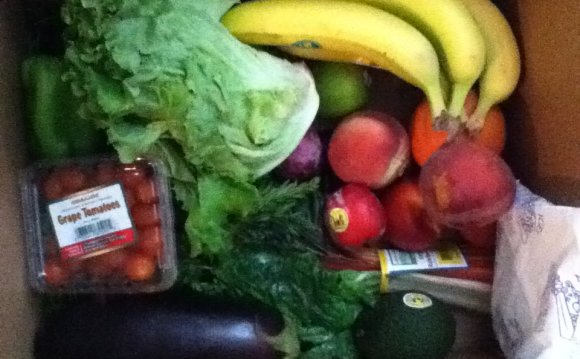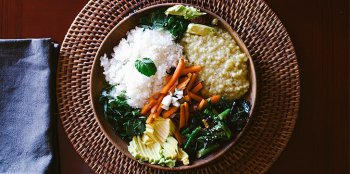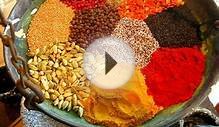
 For many, the concept of food combining – the idea that some foods digest well together while others do not – is entirely new, and somewhat foreign. But according to Ayurveda, it is an essential part of understanding how to eat properly. Careful food combining can dramatically improve the quality of digestion, support the body in receiving a deeper level of nourishment, and positively impact our overall health.
For many, the concept of food combining – the idea that some foods digest well together while others do not – is entirely new, and somewhat foreign. But according to Ayurveda, it is an essential part of understanding how to eat properly. Careful food combining can dramatically improve the quality of digestion, support the body in receiving a deeper level of nourishment, and positively impact our overall health.
However, most people in the modern world are accustomed to eating a number of foods that do not usually digest well together (like fruit with nuts, or beans with cheese). So why does it matter? The Ayurvedic perspective is that each food has a distinct combination of tastes and energies – and a corresponding affect on both the digestive system and on the body as a whole. Combining foods with radically different energetics can overwhelm the digestive fire and can cause indigestion, fermentation, gas, bloating, and the creation of toxins. This is why proper food combining is so important. Of course, certain combinations disturb the digestive tract more than others – an important consideration if this practice is entirely new to you. Regardless of your particular habits or symptoms, paying attention to how you combine foods can provide a valuable opportunity for insight, healing, and improved health.
A Balanced Approach to Food Combining
It is usually best to embrace the idea of food combining slowly and gently, allowing plenty of time to make the necessary adaptations. Some of the recommended adjustments are relatively simple; others can require a major recalibration in our habits, or meet with resistance. Often, simply developing an awareness of improper food combinations that you eat somewhat regularly is a great place to start. Notice which foods you combine that may be difficult to digest together, and how often you indulge in them. Become aware of how you feel afterwards. Do these choices affect your energy level, your digestion, your elimination, the coating on your tongue? Are particular combinations more noticeably influential than others? These are all important pieces of information. They can confirm the importance of proper food combining and can help each of us to identify the food combinations that are the most disruptive to our systems.
When you are feeling motivated and decide that you are ready to start adapting your diet to accommodate more supportive food combinations, consider tackling just one change at a time. Perhaps you’ll start by eating fruits alone, rather than in combination with other foods. Over time, you can gradually progress toward the ideal. While it would certainly be nice to avoid improper food combinations altogether, reducing their frequency can also be incredibly beneficial. If you do find that some specific food combinations are more problematic for you or your loved ones than others, focus your efforts on changing just those in the beginning. The most important first step is to become aware of your needs and your habits; from there, you can evolve an approach to food combining that works for you.
Combinations to Reduce or Avoid
The following list highlights incompatible foods and offers suggestions for more appropriate combinations. It is meant to be a helpful guide, not an exhaustive list. In fact, you may be aware of other combinations that do not work for your body. Honor those instincts. Because this resource is meant to help you determine optimal combinations at a glance, there is some repetition. Combinations listed in all caps are particularly challenging.
| Incompatible Foods: | Supportive Combinations: | |
| Beans | Fruit, milk, cheese, yogurt, eggs, meat, fish | Grains, vegetables, other beans, nuts, seeds |
| Dairy | Depends on the type of dairy; see individual categories below. | |
| Butter & Ghee | Butter may not combine with other foods as universally as ghee. | Grains, vegetables, beans, nuts, seeds, meat, fish, eggs, cooked fruit |
| Cheese | Fruit, beans, eggs, milk, yogurt, hot drinks | Grains, vegetables |
| Milk | Any other food (especially BANANAS, cherries, melons, sour fruits, yeasted breads, eggs, yogurt, meat, fish, kitchari, starches) | Milk is best enjoyed alone… Exceptions: rice pudding, oatmeal, dates, almonds |
| Yogurt | Fruit, beans, MILK, cheese, eggs, meat, fish, nightshades, hot drinks | Vegetables, grains |
| Eggs | MILK, cheese, yogurt, fruit (especially melons), beans, kitchari, potatoes, meat, fish | Grains, non-starchy vegetables |
| Fruits | Any other food (aside from other fruit) *Exceptions: dates with milk, some cooked combinations | Other fruits with similar qualities (i.e. citrus together, apples with pears, a berry medley, etc.) |
| Lemons | Cucumbers, tomatoes, milk, yogurt
Note: lime can be substituted for use with cucumbers and tomatoes. |
Usually ok with other foods, if used in small amounts as a garnish or flavoring. |
| Melons | EVERYTHING (especially dairy, eggs, fried food, grains, starches) *More than most fruit, melons should be eaten alone or not at all. | Other melons (in a pinch)… But it's better to have each type of melon on it's own. |
| Grains | Fruit | Beans, vegetables, other grains, eggs, meat, fish, nuts, seeds, cheese, yogurt |
| Vegetables | Fruit, milk | Grains, beans, other vegetables, cheese, yogurt, meat, fish, nuts, seeds, eggs |
| Nightshades | Fruit (especially melon), cucumber, milk, cheese, yogurt
Note: nightshades include peppers, eggplant, potatoes, and tomatoes. |
Other vegetables, grains, beans, meat, fish, nuts, seeds |
Yes, some of these are staple combinations in many households. Pizza and a number of other beloved Italian dishes combine nightshades with cheese. And who among us hasn’t enjoyed beans with cheese at some time or another? Then there’s the fruit and yogurt taboo… So much for about 80% of all available store-bought varieties of yogurt; next time you indulge in a fruit-flavored yogurt, pay attention to how your digestion feels afterwards.
In addition, there are some specific preparations that are challenging when combined with particular foods.
| Incompatible Combinations: | ||
| Hot Drinks | Mangoes, cheese, yogurt, meat, fish, starches | Most other foods are ok, unless the hot drink contains other foods (i.e. milk, fruit, almond milk, rice milk, etc.), in which case, reference that particular type of food. |
| Leftovers | Freshly cooked foods | Ideally, just other leftovers from the same meal… Preferably not more than 24 hours old. |
RELATED VIDEO












